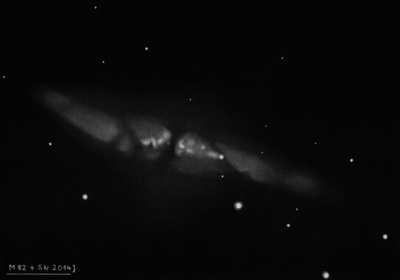Cigar Galaxy
Cigar Galaxy

10x50 binoculars: faintly visible though easier in 15x50's.
Johann Bode discovered M82 = NGC 3034 = H IV-79, along with M81, on 31 Dec 1774. Pierre Méchain independently discovered M82 in Aug 1779.
M82 is not in William Herschel's published catalogues, though on 8 Nov 1801 (sweep 1100) he noted "eB, mE sp-nf, about 10' long" and on 30 Sep 1802 (sweep 1112) he logged "a vB, beautiful ray of light, brightest in the middle of all the length, about 8' long and 2 or 3' broad." John Herschel added it as one of the 8 "HON" objects ("Herschel omitted nebulae") in the Appendix to his Cape Observations (and in the GC as IV-79), as WH assumed it was a new discovery on his last sweep on 30 Sep 1802!
The first published comment about dark lanes was made by Ralph Copeland at Birr Castle on 21 May 1871. He noted "A most extraordinary object, at least 10' in length, and crossed by several dark bands."
200/250mm - 8" bright, spindle, mottled. A dark wedge cuts into the galaxy near the center from the south side.
300/350mm - 13.1" (11/5/83): two obvious dark lanes.
400/500mm - 17.5" (10/12/85): very bright, large, edge-on 4:1 WSW-ENE, 10' x 2.5', large bright irregular core. Very mottled with an unusually high surface brightness. Unique appearance with several dark cuts oblique to the major axis including a prominent wedge or cut nearly through the center. A mag 10 star is just south of the SW end 5.8' from the center
900/1200mm - 48" (4/15/10): stunning view at 330x with numerous irregular dark rifts slicing up the mottled, clumpy surface. Several very small, bright knots or condensations (Super Star Clusters - SSCs) are just west of a dark wedge that pierces the galaxy on the south side and tapers as it cuts across the center at an oblique angle. The very bright section of the galaxy to the northeast of the dark absorption wedge also displays mottled structure. Another prominent dark inclusion cuts into the galaxy from the north on the northeast side of the galaxy. A very faint extension of low surface brightness haze (the superwind outflow) bulges out from the main portion of the galaxy on the south side. This glow is west of the dark wedge and east of a mag 10.5 star located 5.8' SW of center. On images this large bulge appears to explode out from the galaxy with filamentary structure. Overall, there was too much visible structure to describe from a couple of minutes at the eyepiece.
Notes by Steve Gottlieb